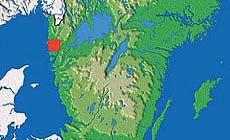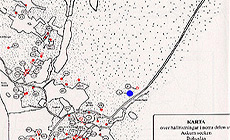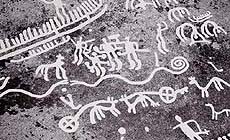|
|
 |
 |
Country: |
Sweden |
Locality: |
Askum raä 2 |
|
 |
Region: |
Bohuslän |
Area: |
Askum |
|
 |
 |
|
|
|
|
| |
 |
Environment & Surface |
 |
 |
 |
|
Open-air
Shelter
Cave
Portable
Megalithic
|
Geography: |
Situated on a sloping rock facing SSE, 58 m NW of a road on a point 45 m NE of corner of field. The carving is situated in woodland, cutting area. |
Proximity: |
The carving is situated 58 m NW of a road, 45 m NE of corner of field. |
|
 |
Geology: |
Granite |
Surface: |
Smooth, sloping rock, partly weathered. |
|
Dimensions:
|
Length 3.20 m.
Width 3.10 m.
|
|
 |
 |
|
|
|
|
| |
 |
Art |
 |
 |
 |
Description: |
Engravings
Paintings
Painted engravings
High or low-relief
Sculpture
The carving is divided into a number of smaller scenes, creating a major composition. The interpretation has been that the carving depicts a cosmological drama which took place in a mythical past.
The ship figures are 23-320 cm long; 3 of the ships are double-lined with crew-strokes including one with a frame stroke. 2 are single-lined including one with crew-strokes. The longest ship has a prow ending in a ring and a spiral which has partly eroded away. This particular boat also has human-like crew-strikes with "knobs for head".
The human figures are 16-39 cm long, all with the body completely carved out. 5 have swords, 5 are phallic, one is wearing horns and 5 are acrobats.
There are 9 animals, 9-97 cm long. 3 are snakes including 2 where the body ends in a spiral. 6 animals are four-legged and of line type.
Here are 2 single-wheeled carts, 39 cm long and 14 cm wide.
The obscure figure is 16 x 8 cm, the fragments 7-14 cm long.
There are 8 cup marks, 3-6 cm ø, 0.5-1.5 cm deep.
|
Figures: |
total number 44
5 ships
16 human figures
9 animals
2 carts
1 obscure figure
3 fragments
8 cup marks
|
|
 |
Chronology: |
Palaeolithic
Epipalaeolithic - Mesolithic
Neolithic
Copper Age
Bronze Age
Iron Age
Roman
Middle Age
Modern
Unknown
The rock carvings of Bohuslän are usually dated to the middle and later part of the Bronze Age, c. 1500-500 BC, and the dating are based upon comparative studies of recognisable objects or figures on the carving. Datable objects like sword types, razors, shields and scenes found in other datable contexts are used as reference material. Detailed chronologies are hard to obtain for the South Scandinavian rock carvings, due to the fact that there are no datable material, and the only method to use is typological comparisons. Several scholars have tried to create inner chronologies for the single rock carving site or a certain figure, for example the numerous ship figures.
|
Notes: |
The oldest data concerning the Askum raä 2 locality originates from Emil Ekhoff in 1886, "Bidrag till kännedom om Göteborgs och Bohusläns fornminnen och historia" (Bengtsson 1997:6).
The work of documenting the Askum carvings began in 1996. The parish were judged as having a workable number of carvings (129) and as being sufficiently small to function as a reference area in which methods could be tried out, and to gain experience in the work of large scale documentation, with regard to time utilisation, transport problems etc. The expectation was to publish all the sites in one collective volume, but the number of carvings was far greater than had been anticipated. The number of carvings has so far more than doubled. The work at Askum has so far been most rewarding for researchers. Many new motifs and combinations of motifs has been documented, and the work has given rise to valuable contributions to the study of the distribution of carvings in the countryside and of the distribution of individual motifs (Bengtsson 1997:2).
The rock carving of Askum raä 2 are special compared to other carvings. The carving is very well composed, and the scenes are unusual. Both the carts, snakes and the acrobats are remainings of the Mediterranean cultures, and similar depictions are found wall-paintings in temples, as miniatures and on pottery (Olsson 1998; 1999; 2000). |
|
 |
 |
|
| |
 |
Bibliography |
 |
|
|
|
|
| |
 |
Conservation |
 |
 |
 |
Status: |
Public
Private
Park
Classified site
|
Risk: |
The major risk for carvings carried out in granite are chemical weathering, which makes the hard quartzite losen up and fall out, leaving white dots on the darker rock surface. Also natural weathering (mechanical weathering) during winter/spring, when water freeze in cracks and openings in the rock, creates major damage to rock faces with carvings. The biological weathering is also a danger to the rock carvings, and even to intense cleaning of the rock surface during documentation can make the rock fragile and expose the carvings to wind, water and air-born pollution. |
|
 |
Conservation: |
Good
Quite good
Mediocre
Bad
|
Intervention: |
Problems concerning conservation and preservation, registration and documentation of rock carvings in Scandinavia are discussed by several departments, i.e. Riksantikvaren in Norway, Riksantikvarieämbetet in Sweden, several universities and research departments. Different methods are tested, for example covering of carved surfaces, measuring of temperature and different contents in water and air and also the composition in the granite. Hollows and cracks in the rock surface can be repaired and carefully filled in. An easy method of taking care of the rock surface is by ordinary sweeping. The Bronze Age environment has been restored by careful site management, mainly by clearing out pine-trees and the lower vegetation in order to create a more open and original environment. |
|
 |
 |
|
|
 |
By |
 |
|
| |
| Record n. 744 / 807 |
No commercial use is allowed. Specific © is mentioned in the captions or owned by each Author or Institution |
|
| |
 |
EuroPreArt, European Prehistoric Art, is a web-based archaeological project funded by the European Union which aims to establish a lasting data-base of European prehistoric art documentation, to launch the base of an European institutional network and to contribute to the awareness of the diversity and richness of European Prehistoric Art.
It is proposed by: Instituto Politécnico de Tomar (IPT, Portugal),
CUEBC - European University Centre for Cultural Heritage (Italy - Europe),
Consejo Superior de Investigaciones Científicas (España),
Asociación Cultural Colectivo Barbaón (España),
Université de Liège (Belgique),
Gotland University College (Sverige),
University College Dublin (Eire),
Cooperativa Archeologica Le Orme dell'Uomo (Italia),
Study Centre and Museum of Prehistoric Art of
Pinerolo (Italia),
The European Centre for Prehistoric Research in the Alto Ribatejo (Portugal),
ArqueoJovem - a youth NGO (Portugal).
|
|
|
|
 |
|
 NEW: Alpine rock paintings
NEW: Alpine rock paintings


